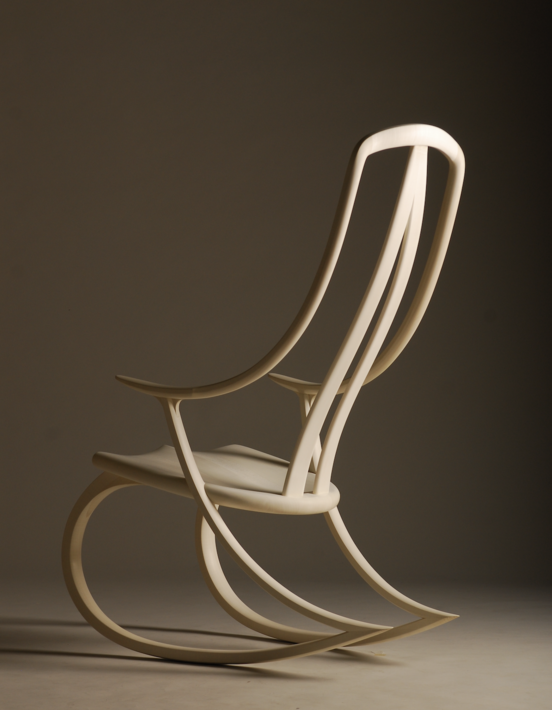Join us to hear stories of furniture design and making in the 80s and 90s from those who experienced it first hand, including David Haig, Justine Olsen, John Shaw, Colin Slade, Neal Smith, David Trubridge and Carin Wilson.
Brought together from across the country, the group will discuss the studio furniture movement, the influential seven-year run of Artiture exhibitions and broader contexts that formed the rich design and making scene of the moment.
Anecdotes and differences of opinion guaranteed. Also your opportunity to hear from these makers about the works they have contributed to The Chair. Don't miss this one.
—
David Haig MNZM is an internationally renowned furniture maker from Whakatū Nelson, Aotearoa New Zealand. Born in Malaya in 1955, and educated in the United Kingdom, Haig moved to New Zealand in 1976. Changing direction after completing a history degree at Oxford University, he began developing his craft as a woodworker. Starting with antique restoration and then simple pieces like chests and tables, Haig gradually developed his own design aesthetic and became interested in chair design in particular. Over the last three decades, he has been commissioned to design and build a wide range of furniture for clients all over the globe. He is best known for the Monogram Rocker.
Justine Olsen was Curator of Applied Art, at Auckland Museum in the late 1980s, when she developed the ‘New Zealand Furniture Exhibition’. Since 2007, she has been Curator of Decorative Art and Design at Te Papa Tongarewa. Her portfolio includes contemporary design and craft as well as modernism. Her current project includes research and writing about Walter Cook, a New Zealand collector of design between 1965 and 1985.
John Shaw is one of Aotearoa New Zealand’s leading studio furniture makers. He is also a fine woodworking tutor and was previously Director of the Centre for Fine Woodworking in Nelson. Shaw received formal training at Rycotewood College in the United Kingdom, and the College of the Redwoods in California, under the guidance there of James Krenov. He presently makes and mentors from his Kanuka Rise Workshop in Wakapuaka, Whakatū Nelson.
Colin Slade served an apprenticeship in chairmaking from 1966–70 in High Wycombe. Known as the home of English furniture-making, the town’s predominant industry was due to the abundant surrounding beech forests. He came to New Zealand in 1972; settling in Christchurch four years later, he opened a chair making business on Ferry Road in 1978. Slade was a founding member of the Canterbury Guild of Woodworkers in 1979, he was a member of the Furniture Group and served as President of the Crafts Council from 1985–87. From 1982, Slade wrote extensively on craft and fine woodworking, and advocated for the value of craft-based practice and the art form of furniture making. Slade stopped full-time furniture making in 1998.
Neal Smith grew up in rural Aotearoa New Zealand, the breeding ground for observation, curiosity and making things. After starting out as a biochemistry technician at the Department of Scientific and Industrial Research and Otago University he graduated from the Wellington School of Design, which led to hands-on furniture making and integrating design with practice. A natural progression led to becoming head designer for Aotearoa’s largest furniture manufacturer and to experiencing the realities of large-scale mass production and marketing, locally and internationally. This experience eventually generated the need to reconnect with a more authentic and personal interpretation of design, and the creation of Neal Smith Design as an independent design practice.
David Trubridge ONZM is a self-taught craftsperson who has pursued a career as a designer and maker of furniture inspired by the natural world and created by reconciling traditional techniques and contemporary technologies. Born in Oxford, England, in 1951, Trubridge grew up in the maritime environment of the Isle of Wight and gained a degree in naval architecture from Newcastle University. Trubridge arrived in Aotearoa New Zealand in 1985 after a five-year sailing voyage. Influenced by his encounters with oceanic cultures, Trubridge began making furniture that drew on indigenous craft traditions. In 1992 the family moved to Karanema Havelock North; since then, Trubridge has grown his artisan practice into an internationally renowned design and manufacturing brand. At the Milan Furniture Fair in 2001 he achieved breakthrough recognition with the organically formed, timber-slatted Body Raft recliner. Trubridge has participated in numerous international exhibitions and his work has been collected by institutions including the Victoria and Albert Museum, London, and the Pompidou Centre, Paris. In 2007 he received the John Britten Award, Aotearoa’s leading design award, and in 2019 he was appointed Officer of the New Zealand Order of Merit.
Carin Wilson (Ngāti Awa, Tūhourangi) is a studio furniture maker, sculptor and design educator. He was a leader in the country’s craft movement in the 1970s, 80s and 90s, and helped initiate the design showcase Artiture in 1987. Wilson holds an Honorary Diploma in Art and Design from Whitecliffe College of Arts and Design, and in 2002 he received one of the inaugural Toi Iho marks, a registered Māori trademark of authenticity. His design practice, Studio Pasifika, has been in operation since 1993. Wilson is represented by Artis Gallery in Tāmaki Makaurau Auckland and Kura Gallery in Te Whanganui-a-Tara Wellington. In 2000 Wilson was one of the rōpū (group) of Māori artists and designers who established Ngā Aho to bring a stronger Māori perspective to design practice in Aotearoa. Wilson was the President of the Crafts Council of New Zealand from1982-85.

David Haig, Monogram Rocker, 2020. Private Collection. Photograph by Daniel Allen.

John Shaw, Walnut Chair, 2008. Courtesy of John Shaw. Photograph by Sam Hartnett.

Neal Smith, RYB Chair, 1989. Courtesy of Neal Smith. Photograph by David Straight.

David Trubridge, Dining Chair, 1994. Private Collection. Photograph by Sam Hartnett.